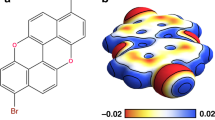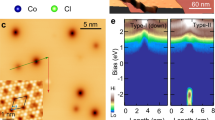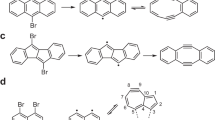Abstract
One-dimensional nanostructures at silicon surfaces have potential applications in nanoscale devices. Here we propose a mechanism of dipole-directed assembly for the growth of lines of physisorbed dipolar molecules. The adsorbate chosen was a halide, in preparation for the patterned imprinting of halogen atoms. Using scanning tunnelling microscopy, physisorbed 1,5-dichloropentane on Si(100)-2×1 was shown to self-assemble at room temperature into molecular lines that grew predominantly perpendicular to the Si-dimer rows. Line formation was triggered by the displacement of surface charge by the dipolar adsorbate. Experimental and simulated scanning tunnelling microscopy images were in agreement for a range of positive and negative bias voltages. The geometry of the physisorbed molecules and nature of their binding were evident from the scanning tunnelling microscopy images, as interpreted by scanning tunnelling microscopy simulation.
This is a preview of subscription content, access via your institution
Access options
Subscribe to this journal
Receive 12 print issues and online access
$259.00 per year
only $21.58 per issue
Buy this article
- Purchase on Springer Link
- Instant access to full article PDF
Prices may be subject to local taxes which are calculated during checkout




Similar content being viewed by others
References
Naitoh, M., Shimaya, H., Nishigaki, S., Oishi, N. & Shoji, F. Scanning tunneling microscopy observation of bismuth growth on Si(100) surfaces. Surf. Sci. 377–379, 899–903 (1997).
Naitoh, M., Shimaya, H., Nishigaki, S., Oishi, N. & Shoji, F. Scanning tunneling microscopy observation of Bi-induced surface structures on the Si(100) surface. Surf. Sci. 482–485, 1440–1444 (2001).
Owen, J. H. G., Miki, K. & Bowler, D. R. Self-assembled nanowires on semiconductor surfaces. J. Mater. Sci. 41, 4568–4603 (2006).
MacLeod, J. M. & McLean, A. B. Single 2 × 1 domain orientation on Si(100) surfaces using a periodic Bi line arrays. Phys. Rev B 70, 041306 (2004).
MacLeod, J. M., Miwa, R. H., Srivastava, G. P. & McLean, A. B. The electronic origin of contrast reversal in bias-dependent STM images of nanolines. Surf. Sci. 576, 116–122 (2005).
Preinesberger, C., Vandre, S., Kalka, T. & Dahne-Preitsch, M. Formation of dysprosium silicide wires on Si(001). J. Phys. D 31, L43–L45 (1998).
Chen, Y., Ohlberg, D. A. A. & Williams, R. S. Nanowires of four epitaxial hexagonal silicides grown on Si(001). J. Appl. Phys. 91, 3213–3218 (2002).
Nogami, J., Liu, B. Z., Katkov, M. V., Ohbuchi, C. & Birge, N. O. Self-assembled rare earth silicide nanowires on Si(001). Phys. Rev. B 63, 233305 (2001).
Liu, B. Z. & Nogami, J. Growth of parallel rare earth silicide nanowire arrays on vicinal Si(001). Nanotechnology 14, 873–877 (2003).
Liu, B. Z. & Nogami, J. An STM study of the Si(001)(2×4)-Dy surface. Surf. Sci. 488, 399–405 (2001).
Ohbuchi, C. & Nogami, J. Holmium growth on Si(001): Surface reconstructions and nanowire formation. Phys. Rev. B 66, 165323 (2002).
Katkov, M. V. & Nogami, J. Yb and Nd growth on Si(001). Surf. Sci. 524, 129–136 (2003).
Ohbuchi, C. & Nogami, J. Samarium induced surface reconstructions of Si(001). Surf. Sci. 579, 157–165 (2005).
Harrison, B. C. & Boland, J. J. Real-time STM study of inter-nanowire reactions: GdSi2 nanowires on Si(100). Surf. Sci. 594, 93–98 (2005).
Evans, M. M. R. & Nogami, J. Indium and gallium on Si(001): A closer look at the parallel dimer structure. Phys. Rev. B 59, 7644–7648 (1999).
Nogami, J., Baski, A. A. & Quate, C. F. Aluminum on the Si(100) surface: Growth of the first monolayer. Phys. Rev. B 44, 1415–1418 (1991).
Glueckstein, J. C., Evans, M. M. R. & Nogami, J. Growth of Sn on Si(001) at room temperature. Surf. Sci. 415, 80–94 (1998).
Itoh, H., Tanabe, H., Winau, D., Schmid, A. K. & Ichinokawa, T. Growth mode and surface structures of the Pb/Si(001) system observed by scanning tunneling microscopy. J. Vac. Sci. Tech. B 12, 2086–2089 (1994).
Tomatsu, K., Nakatsuji, K., Iimori, T. & Komori, F. STM observation of initial growth of Sn atoms on Ge(001) surface. Surf. Sci. 601, 1736–1746 (2007).
Hutchison, P., Evans, M. M. R. & Nogami, J. Mg growth on the Si(001) surface: An STM study. Surf. Sci. 411, 99–110 (1998).
Bakhtizin, R. Z., Kishimoto, J., Hashizume, T. & Sakurai, T. STM study of Sr adsorption on Si(100) surface. Appl. Surf. Sci. 94, 478–484 (1996).
Bird, C. F. & Bowler, D. R. A spin polarized first-principles study of short dangling bond wires on Si(001). Surf. Sci. 531, L351–L355 (2003).
Chen, T. C. et al. Atomic-scale desorption through electronic and vibrational excitation mechanisms. Science 268, 1590–1592 (1995).
Cyr, C. M., Venkataraman, B. & Flynn, G. W. Functional group identification in scanning tunneling microscopy of molecular adsorbates. J. Phys. Chem. 100, 13747–13759 (1996).
Canas-Ventura, M. E. et al. Coexistence of one- and two-dimensional supramolecular assemblies of terephthalic acid on Pd(111) due to self-limiting deprotonation. J. Chem Phys. 125, 184710 (2006).
Lopinski, G. P., Wayner, D. D. M. & Wolkow, R. A. Self-directed growth of molecular nanostructures on silicon. Nature 406, 48–51 (2000).
DiLabio, G. A., Piva, P. G., Kruse, P. & Wolkow, R. A. Dispersion interactions enable the self-directed growth of linear alkane nanostructures covalently bound to silicon. J. Am. Chem. Soc. 126, 16048–16050 (2004).
Kruse, P., Johnson, E. R., DiLabio, G. A. & Wolkow, R. A. Patterning of vinylferrocene on H–Si(100) via self-directed growth of molecular lines and STM-induced decomposition. Nano Lett. 2, 807–810 (2002).
Hossain, M. Z., Kato, H. S. & Kawai, M. Controlled fabrication of 1D molecular lines across the dimer rows on the Si(100)-(2 × 1)-H surface through the radical chain reaction. J. Am. Soc. Chem. 127, 15030–15031 (2005).
Hossain, M. Z., Kato, H. S. & Kawai, M. Fabrication of interconnected 1D molecular lines along and across the dimer rows on the Si(100)-(2 × 1)-H surface through the radical chain reaction. J. Phys. Chem. B 109, 23129–23133 (2005).
Shimomura, M. et al. Formation of one-dimensional molecular chains on a solid surface: Pyrazine/Si(001). Phys. Rev. B 72, 033303 (2005).
Wang, Y., Chen, X. & Hamers, R. J. Atomic-resolution study of overlayer formation and interfacial mixing in the interaction of phosphorus with Si(001). Phys. Rev. B 50, 4534–4547 (1994).
Kipp, L. et al. Adsorption and decomposition on Si(100) 2 × 1 studied by STM. Phys. Rev. B 52, 5843–5850 (1995).
Knall, J. & Pethica, J. B. Growth of Ge on Si(100) and Si(113) studied by STM. Surf. Sci. 265, 156–167 (1992).
Park, Ch., Bakhizin, R. Z., Hashizume, T. & Sakurai, T. Strain relief and ordering of (2 × n)-Bi structure on Si(100). J. Vac. Sci. Technol. B 12, 2049–2051 (1994).
Wang, Y. & Hwang, G. S. Two-dimension arrangement of CH3NH2 adsorption on Si(001)-2×1. Chem. Phys. Lett. 385, 144–148 (2004).
Wang, Y. & Hwang, G. S. Origin of nonlocal interactions in adsorption of polar molecules on Si(001)-2×1. J. Chem. Phys. 122, 164706 (2005).
Gao, Q., Cheng, C. C., Chen, P. J., Choyke, W. J. & Yates, J. T. Jr. Chlorine bonding sites and bonding configurations on Si(100)-2 × 1. J. Chem. Phys. 98, 8308–8323 (1993).
Szabo, A., Farrall, P. D. & Engel, T. Reactions of chlorine with Si(100) and Si(111): Adsorption and desorption kinetics. Surf. Sci. 312, 284–300 (1994).
Gupta, P., Coon, P. A., Koehler, B. G. & George, S. M. Desorption product yields following Cl2 adsorption on Si(111)-7 × 7: Coverage and temperature dependence. Surf. Sci. 249, 92–104 (1991).
Dobrin, S. et al. Self-assembled molecular corrals on a semiconductor surface. Surf. Sci. 600, 43–47 (2006).
Dubois, M., Delerue, C. & Rubio, A. Adsorption and electronic excitation of biphenyl on Si(100): a theoretical STM analysis. Phys. Rev. B 75, 041302 (2004).
Grandidier, B. et al. Effect of alkyl substituents on the adsorption of thienylenevinylene oligomers on the Si(100) surface. Surf. Sci. 473, 1–7 (2001).
Lei, R. Z., Gellman, A. J. & Koel, B. E. Desorption energies of linear and cyclic alkanes on surfaces: Anomalous scaling with length. Surf. Sci. 554, 125–140 (2004).
Dobrin, S. et al. Molecular dynamics of haloalkane corral-formation and surface halogenation at Si(111)-7 × 7. J. Chem. Phys. 125, 133407 (2006).
Grandidier, B. et al. Effect of alkyl substituents on the adsorption of thienylenevinylene oligomers on the Si(100) surface. Surf. Sci. 473, 1–7 (2001).
Dubois, M., Delerue, C. & Allan G. Scanning tunneling microscopy and spectroscopy of conjugated oligomers weakly bonded to Si(100) surfaces: A theoretical study. Phys. Rev. B 71, 165435 (2005).
Kondo, Y., Amakusa, T., Iwatsuki, M. & Tokomoto, H. Phase transition of the Si(001) surface below 100 K. Surf. Sci. 453, L318–L322 (2000).
Lyubinetsky, I., Dohnalek, Z., Choyke, W. J. & Yates, J. T. Jr. Cl2 dissociation on Si(100)-(2 × 1): A statistical study by scanning tunneling microscopy. Phys. Rev. B 58, 7950–7957 (1998).
Okada, H., Fujimoto, Y., Endo, K., Hirose, K. & Mori, Y. Detailed analysis of scanning tunneling microscopy images of the Si(001) reconstructed surface with buckled dimers. Phys. Rev. B 63, 195324 (2001).
Oura, K., Lifshits, V. G., Saranin, A. A., Zotov, A. V. & Katayama, M. Surface Science: An Introduction 181–183 (Springer-Verlag, Berlin, 2003).
Bartmess, J. E. & Georgiadis, R. M. Empirical methods for determination of ion gauge sensitivities for different gases. Vacuum 33, 149–153 (1983).
Kresse, G. & Hafner, J. Ab initio molecular dynamics for liquid metals. Phys. Rev. B 47, 558–561 (1993).
Kresse, G. & Furthmüller, J. Efficient iterative schemes for ab initio total-energy calculations using a plane-wave basis set. Phys. Rev. B 54, 11169–11186 (1996).
Perdew, J. P. et al. Atoms, molecules, solids, and surfaces: Applications of the generalized gradient approximation for exchange and correlation. Phys. Rev. B 46, 6671–6687 (1992).
Hofer, W. A. & Redinger, J. STM of binary alloys: First principles calculation of the current for PtX(100) surfaces. Surf. Sci. 447, 51–61 (2000).
Palotas, K. & Hofer, W. A. Multiple scattering in a vacuum barrier obtained from real-space wavefunctions. J. Phys. Condens. Matter 17, 2705–2713 (2005).
Acknowledgements
The authors are indebted to the Natural Sciences and Engineering Research Council of Canada (NSERC), the Ontario Centers of Excellence (OCE) Centre for Photonics, the Canadian Institute for Photonic Innovation (CIPI), and the Canadian Institute For Advanced Research (CIFAR) for their support. We thank L. Leung for helpful discussions. W.A.H. thanks the Royal Society for financial support.
Author information
Authors and Affiliations
Contributions
The experiments were performed jointly by K.R.H., T.L., I.R.M. and J.C.P. at the University of Toronto, and the computations by L.Z., S.A. and W.A.H. at the University of Liverpool.
Corresponding author
Rights and permissions
About this article
Cite this article
Harikumar, K., Lim, T., McNab, I. et al. Dipole-directed assembly of lines of 1,5-dichloropentane on silicon substrates by displacement of surface charge. Nature Nanotech 3, 222–228 (2008). https://doi.org/10.1038/nnano.2008.65
Received:
Accepted:
Published:
Issue Date:
DOI: https://doi.org/10.1038/nnano.2008.65
This article is cited by
-
Direct measurements of the colloidal Debye force
Nature Communications (2023)
-
Heisenberg, uncertainty, and the scanning tunneling microscope
Frontiers of Physics (2012)
-
Cooperative molecular dynamics in surface reactions
Nature Chemistry (2009)
-
Silicon falls into line
Nature Nanotechnology (2008)



